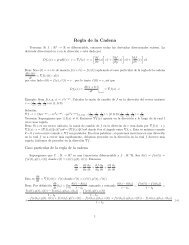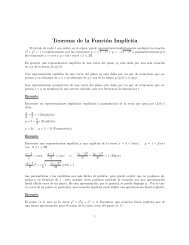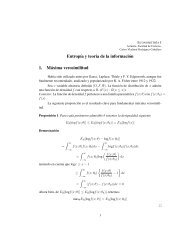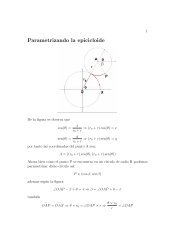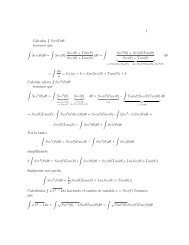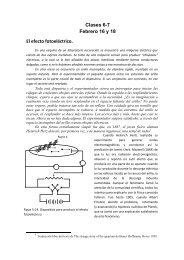"Surely You're Joking, Mr. Feynman!" - unam.
"Surely You're Joking, Mr. Feynman!" - unam.
"Surely You're Joking, Mr. Feynman!" - unam.
Create successful ePaper yourself
Turn your PDF publications into a flip-book with our unique Google optimized e-Paper software.
super: He answered everything nifty! The examiners asked him what diamagnetism was,<br />
and he answered it perfectly. Then they asked, "When light comes at an angle through a<br />
sheet of material with a certain thickness, and a certain index N, what happens to the<br />
light?"<br />
"It comes out parallel to itself, sir displaced."<br />
"And how much is it displaced?"<br />
"I don't know, sir, but I can figure it out." So he figured it out. He was very good.<br />
But I had, by this time, my suspicions.<br />
After the exam I went up to this bright young man, and explained to him that I<br />
was from the United States, and that I wanted to ask him some questions that would not<br />
affect the result of his examination in any way. The first question I ask is, "Can you give<br />
me some example of a diamagnetic substance?"<br />
"No."<br />
Then I asked, "If this book was made of glass, and I was looking at something on<br />
the table through it, what would happen to the image if I tilted the glass?"<br />
"It would be deflected, sir, by twice the angle that you've turned the book."<br />
I said, "You haven't got it mixed up with a mirror, have you?"<br />
"No, sir!"<br />
He had just told me in the examination that the light would be displaced, parallel<br />
to itself, and therefore the image would move over to one side, but would not be turned<br />
by any angle. He had even figured out how much it would be displaced, but he didn't<br />
realize that a piece of glass is a material with an index, and that his calculation had<br />
applied to my question.<br />
I taught a course at the engineering school on mathematical methods in physics, in<br />
which I tried to show how to solve problems by trial and error. It's something that people<br />
don't usually learn, so I began with some simple examples of arithmetic to illustrate the<br />
method. I was surprised that only about eight out of the eighty or so students turned in the<br />
first assignment. So I gave a strong lecture about having to actually try it, not just sit back<br />
and watch me do it.<br />
After the lecture some students came up to me in a little delegation, and told me<br />
that I didn't understand the backgrounds that they have, that they can study without doing<br />
the problems, that they have already learned arithmetic, and that this stuff was beneath<br />
them.<br />
So I kept going with the class, and no matter how complicated or obviously<br />
advanced the work was becoming, they were never handing a damn thing in. Of course I<br />
realized what it was: They couldn't do it!<br />
One other thing I could never get them to do was to ask questions. Finally, a<br />
student explained it to me: "If I ask you a question during the lecture, afterwards<br />
everybody will be telling me, 'What are you wasting our time for in the class? We're<br />
trying to learn something. And you're stopping him by asking a question'."<br />
It was a kind of oneupmanship, where nobody knows what's going on, and they'd<br />
put the other one down as if they did know. They all fake that they know, and if one<br />
student admits for a moment that something is confusing by asking a question, the others<br />
take a highhanded attitude, acting as if it's not confusing at all, telling him that he's<br />
wasting their time.<br />
I explained how useful it was to work together, to discuss the questions, to talk it




